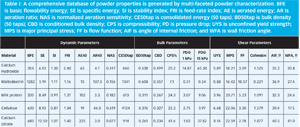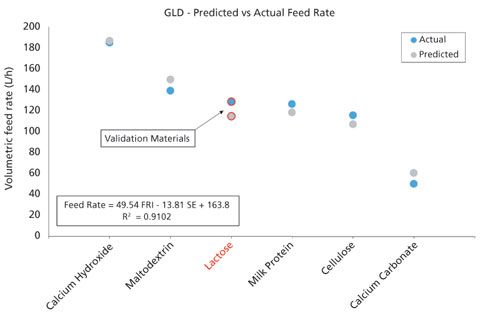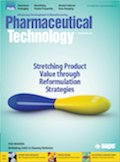Identifying Powder Properties that Define Process Performance
Multi-faceted powder characterization, including measurement of dynamic properties, can be used to correlate powder properties and process performance to support equipment selection, optimization, and troubleshooting.
Improved, knowledge-led powder processing has a vital role to play in transforming manufacturing efficiency in the pharmaceutical industry. The successful commercialization of continuous manufacturing, the realization of real-time release, and the competitive development of generic drugs all rely on understanding how to optimize the handling and processing of powders. It is essential, therefore, to develop strategies and tools to supply insight into powder properties.
Powders consist of three distinct phases: solids (particles), air, and often water. Interactions between these phases give rise to the unique, industrially valuable properties that powders exhibit, but at the same time make it impractical to predict powder behavior from the properties of constituent components. Multi-faceted powder characterization has proven to be a pragmatic alternative. This approach generates a database that can be used to identify the properties that correlate most strongly with process performance.
Powder properties can be used, for example, to predict the volumetric flow rate through a screw feeder. Screw feeders are used routinely within the pharmaceutical industry to control the flow of material from one part of the process to another, typically from a feed hopper into a processing vessel. A poorly specified feeder-one that is unsuited to the powder it is handling-may deliver low or erratic powder feed rates, may block completely, or may even increase the risk of batch-to-batch contamination from powder accumulated on the walls of the feeder. The following case study shows how to identify powder properties that can be used to predict screw-feeder performance with a high degree of certainty.
Characterizing powder properties
The properties of six different powders (calcium hydroxide, maltodextrin, milk protein, cellulose, calcium citrate, and lactose) were measured with an FT4 Powder Rheometer (Freeman Technology) using methods for measuring dynamic, bulk, and shear properties (1). Table I summarizes the results. The dynamic properties of basic flowability energy (BFE), specific energy (SE), aeration energy (AE), and flow rate index (FRI) directly quantify how easily the powder flows under different conditions, such as when unconfined, forced to flow, or aerated. Bulk properties such as compressibility, permeability, and bulk density deliver insight into the packing behavior of particles within the powder bed and the ease with which the bed retains and releases air. Shear properties include the parameters flow function and unconfined yield strength, which relate to the cohesivity of a powder stored under consolidation and are widely used to design powder hoppers. These data are an important resource for process optimization.
CLICK TABLE TO ENLARGE

Table I. A comprehensive database of powder properties is generated by multi-faceted powder characterization. .
Quantifying process performance
The second step in developing robust correlations for process optimization is to identify those metrics that define process performance. Factors that influence screw-feeder specification include installation constraints, process requirements, and material properties, but feed capacity is usually the primary design parameter. Being able to predict feed capacity for any given powder is therefore crucial. Design variables that can be manipulated to meet specification criteria include the size of the feeder (i.e., diameter and length) and the geometry, drive, and pitch of the auger. Feed rate may be controlled on the basis of weight (gravimetric) or volume (volumetric).
Samples of all of the powders characterized in the first stage of the study were run through two different screw-feeder models. The first was a compact, full-flight single-screw feeder (DIWE-GLD-87 VR, tube No. 3, Gericke) used for high accuracy, dry solid feeding, pilot-scale studies, and applications requiring frequent material changeover. The second was a flat-bottom, double-screw feeder (DIWE-GZD, 12x13.5mm tube with a conical core, Gericke), a self-cleaning, twin-screw extruder used for low-capacity applications and handling poorly flowing materials.
Table II shows the volumetric flow rate delivered by each feeder, operated at an auger rotation speed equivalent to 80 Hz. Volumetric flow rate (in L/hr) was calculated from measurements of mass flow rate (in kg/hr) and poured density. Performance of the feeder varies significantly as a result of the differing properties of the materials.
Producing a robust correlation
Performing a multiple linear regression using both sets of measured data reveals correlations between individual powder properties and the volumetric flow rate from the feeder. In basic terms, this mathematical process quantifies the probability that any specific parameter is making a statistically significant contribution to a developing correlation. The smaller the p value, the more likely it is that an independent x variable (in this case a powder property) is influencing the dependent y parameter (volumetric flow rate through the feeder).
For this study, a p value of 0.1 was taken as the upper limit for relevance, and parameters with p values higher than this were eliminated to derive a robust relationship. Data for five of the powders were included in the linear regression exercise, leaving the lactose data available for testing the predictive powers of the developed model.
For the single-screw feeder, this analysis generated the following relationship, where FRI is flow rate index and SE is specific energy:
Feed Rate = 49.54 FRI – 13.81 SE + 163.8
For the double screw feeder, the observed relationship was as follows, where AE is aerated energy:
Feed Rate = -0.1114 AE40 + 34.82
Both of these models are statistically robust, as indicated by the R2 values (0.9466 and 0.8383, respectively), which quantify the ‘goodness of fit’ between the model and the data. Furthermore, both are relatively simple in terms of the number of the powder properties that are found to be of significance. For the single-screw feeder, two dynamic properties (FRI and SE) are needed to robustly predict feeder performance, while for the double screw feeder, only AE is considered to be statistically significant.
The parameter SE reflects the flow characteristics of a powder in an unconfined state, while FRI describes whether a powder’s resistance to flow increases or decreases as it is induced to flow at a higher or lower rate. Incidentally, all the powders assessed in this study generated an FRI above 1, indicating that they offer less resistance to flow as the rate of flow increases.
AE is a parameter that directly quantifies how a powder flows when aerated. With a cohesive powder, aeration does little to reduce resistance to flow, but for a free-flowing powder, AE can become very low as the powder fluidizes. The materials tested in this study exhibit a relatively broad range of AE values, but a robust relationship between AE and volumetric flow rate for the double-screw feeder holds for all materials.
In addition to the fact that the derived correlations are relatively simple, it is also interesting to note that both contain only dynamic powder properties, which indicates that dynamic powder properties are more relevant to behavior in this particular process than any of the measured shear and bulk properties. An analogous study employing more traditional testing techniques, such as tapped density methods (Carr’s Index/Hausner Ratio) or shear cell analysis, would have failed to produce a robust correlation for process optimization studies.
Testing the model
To challenge the reliability of the derived models, the equations were used to predict the performance of lactose from its measured properties. Figure 1 shows that the models predict feeder performance well, with revised R2 values showing little deviation from those of the initially developed correlations.

Figure 1. Robust correlations enable the prediction of volumetric feeder flow rate from measurable powder properties for (a) the single-screw feeder (GLD) and (b) double-screw feeder (GZD). FRI is feed-rate index; SE is specific energy; AE is aerated energy; R2 is a measure of the fit of the data to the model. All figures are courtesy of the author.

These results demonstrate the value of the outlined strategy for producing robust correlations to support equipment selection, optimization, and troubleshooting. They also illustrate the importance of a multi-faceted approach to powder testing and the need to incorporate dynamic powder testing. In these examples, different powder properties proved most relevant for the prediction of performance in different feeders, but in both cases, dynamic powder properties were of most value.
Reference
R. Freeman, Pow. Tech. 174 (1) 25–33 (2007).
About the author
Jamie Clayton is operations director at Freeman Technology, 1 Miller Court, Severn Drive, Tewkesbury, Gloucestershire, GL20 8DN, tel: +44 (0) 1684 851551, info@freeemantech.co.uk
Article DetailsPharmaceutical Technology
Vol. 39, No. 10
Pages: 72–76
Citation:
When referring to this article, please cite it as J. Clayton, "Identifying Powder Properties that Define Process Performance," Pharmaceutical Technology 39 (10) 2015.

Drug Solutions Podcast: A Closer Look at mRNA in Oncology and Vaccines
April 30th 2024In this episode fo the Drug Solutions Podcast, etherna’s vice-president of Technology and Innovation, Stefaan De Koker, discusses the merits and challenges of using mRNA as the foundation for therapeutics in oncology as well as for vaccines.
Pharmaceutical Tariffs Are Imminent: How Industry is Bracing for Impact
April 16th 2025On April 14, 2025, the Trump Administration launched a national security-driven investigation into pharmaceuticals, a move that will likely result in tariffs being placed on pharmaceutical drugs, ingredients, and other components that are imported from outside of the United States.